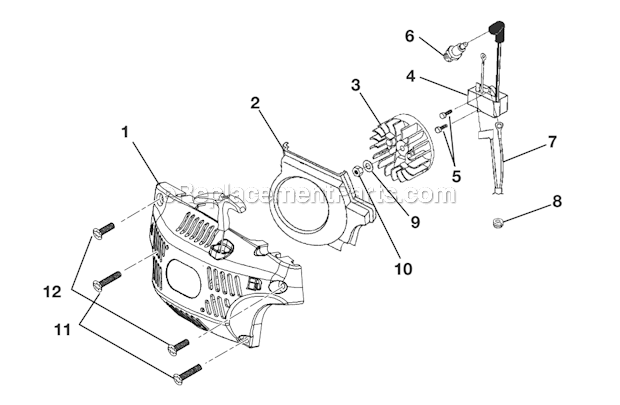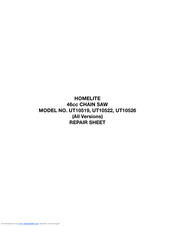Ut10530 Repair Manual
(406 mm) 33cc Chain Saw UT10530, UT10530A, UT10947D, UT10947E Your new chain saw has been engineered and manufactured to Homelite’s high standard for dependability, ease of operation, and operator safety. Properly cared for, it will give you years of rugged, trouble-free performance. IMPORTANT Servicing requires extreme care and knowledge and should be performed only by a qualified service technician. When servicing use only identical Homelite replacement parts.
For safe operation, read and understand all instructions before using the chain saw. Follow all safety instructions. WARNING: The warnings, labels, and instructions found in this section of the operator's manual are for your safety. Failure to follow all instructions may result in serious personal injury. Safe operation of this tool requires that you read and understand this operator's manual and all labels affixed to the tool. ALL CHAIN SAW SERVICE, other than the items listed in the instruction manual and all maintenance, should be performed by competent chain saw service personnel. (For example, if improper tools are used to remove the flywheel or if an improper tool is used to hold the flywheel in order to remove the clutch, structural damage to the flywheel could occur and subsequently could cause the flywheel to burst.).
Refer to “Operation” later in this manual. If the saw chain still moves at idle speed after adjustment has been made, contact a Homelite Service Center for adjustment and discontinue use until the repair is made. Important: Some of the following symbols may be used on your tool. Please study them and learn their meaning. Proper interpretation of these symbols will allow you to operate the tool better and safer. SYMBOL NAME Safety Alert Symbol Read Your Operator’s Manual Eye, Hearing, and Head Protection SAFE-T-TIP Nose Guard No Smoking. The purpose of safety symbols is to attract your attention to possible dangers.
The safety symbols, and the explanations with them, deserve your careful attention and understanding. The safety warnings do not by themselves eliminate any danger. The instructions or warnings they give are not substitutes for proper accident prevention measures. While squeezing both the trigger release and throttle trigger, push in the throttle lock button. Release the throttle trigger.
Repair Manual
This latches the trigger for starting. When the temperature is above 50° F, pull the STARTER GRIP until the engine attempts to start, but no more than 3 times. The carburetor will permit only limited adjust- ment of the “L” (Low Jet) and “H” (High Jet) needles. Any adjustment should be done by a Homelite Service Center. Under no circumstances should the “L” (Low Jet) and “H” (High Jet) needles be forced outside the range of adjust- ment.
If the chain turns at idle, turn the idle speed screw “ T ” counterclockwise to reduce the idle RPM and stop the chain movement. If the saw chain still moves at idle speed, contact a Homelite Service Center for adjust- ment and discontinue use until the repair is made. WARNING: THE SAW CHAIN SHOULD NEVER TURN AT IDLE. PROPER PROCEDURE FOR TREE FELLING See Figures 27 through 30. Pick your escape route (or routes in case the in- tended route is blocked).
Clear the immediate area around the tree and make sure there are no obstruc- tions in your planned path of retreat. Clear the path of safe retreat approximately 135°. Note: Never cut through to the notch. Always leave a band of wood between the notch and back cut (approxi- mately 2 inches (5 cm) or 1/10 the diameter of the tree). This is called 'hinge' or 'hingewood'.
It controls the fall of the tree and prevents slipping or twisting or shoot- back of the tree off the stump. REMOVING BUTTRESS ROOTS See Figure 31. A buttress root is a large root extending from the trunk of the tree above the ground.
Remove large buttress roots prior to felling. Make the horizontal cut into the buttress first, followed by the vertical cut. Remove the resulting loose section from the work area. LIMBING AND PRUNING See Figure 36. Work slowly, keeping both hands on the saw with a firm grip. Maintain secure footing and balance.
Keep the tree between you and the chain while limbing. Do not cut from a ladder, this is extremely dangerous.
Leave this operation for professionals. ASSEMBLING THE BAR AND CHAIN See Figures 38 through 48. DANGER: Never start the engine before installing the guide bar, chain, drivecase cover, and clutch drum. Without all these parts in place, the clutch can fly off or explode exposing the user to possible serious injury.
WARNING: To avoid serious personal injury, read and under- stand all the safety instructions in this section. Replace the outer guide bar plate ensuring that the bar pin groove is at the bottom with the upper and lower edges angled away from the guide bar.
Replace the clutch cover and bar mounting nuts. Tighten the bar mounting nuts finger tight only. The bar must be free to move for tension adjustment. ADJUSTING THE CHAIN TENSION See Figures 49 through 51. WARNING: Never touch or adjust the chain while the motor is running. The saw chain is very sharp. Always wear protective gloves when performing maintenance on the chain.
Stop the engine before setting the chain tension. TOP PLATE FILING ANGLE See Figure 60. CORRECT 30° - file holders are marked with guide marks to align file properly to produce correct top plate angle. LESS THAN 30° – for cross cutting. MORE THAN 30° – feathered edge dulls quickly.
SIDE PLATE ANGLE See Figure 61. MAINTAINING THE GUIDE BAR See Figure 65. CAUTION: Make sure the chain has stopped before you do any work on the saw. Every week of use, reverse the guide bar on the saw to distribute the wear for maximum bar life. The bar should be cleaned every day of use and checked for wear and damage. Air Filter” earlier in this manual.
Clean spark arrestor screen. Refer to “Maintenance – Cleaning the Spark Arresting Muffler” earlier in this manual. Contact a Homelite Service Center for carburetor adjustment. Page 33 Chain Part Number 984296005. Note: The carburetor adjustment needle(s) are equipped with plastic cap(s) that prevent counterclockwise rotation from the original factory adjustment. If your product exhibits specific performance problem(s) where the Troubleshooting Section recommends a counterclockwise needle adjustment and you have made no adjustments since the original purchase, take the product to a factory authorized service center for repair. The equipment engine must be free from defects in material and workmanship which cause it to fail to conform with U.S.
EPA standards for the first two years of engine use from the date of sale to the ultimate purchaser. Homelite Consumer Products, Inc., must warranty the emission control system on your utility/lawn/garden equipment engine for the period of time listed above provided there has been no abuse, neglect, or improper maintenance of your utility/lawn/garden equipment engine. OPERATOR'S MANUAL 16 in.
Power trim and tilt kit 826729a4 various years rigging parts trim various years rigging parts trim tilt lift systems and ponents 1994 up. Mercury 115 elpto service manual. Img17 mercury wiring diagram wiring diagrams boat ignition wiring diagram mercury copy outboard diagrams mastertech marin of.
(406 mm) 33cc Chain Saw UT10530, UT10530A, UT10947D, UT10947E WARNING: The engine exhaust from this product contains chemicals known to the State of California to cause cancer, birth defects or other reproductive harm. CALIFORNIA PROPOSITION 65 For product information, technical help, dealer locations or parts ordering information visit our website at: www.homelite.com.
A complete manual for the device Homelite UT10530, how should it look like? A manual, also referred to as a user manual, or simply 'instructions' is a technical document designed to assist in the use Homelite UT10530 by users. Manuals are usually written by a technical writer, but in a language understandable to all users of Homelite UT10530. A complete Homelite manual, should contain several basic components.


Some of them are less important, such as: cover / title page or copyright page. However, the remaining part should provide us with information that is important from the point of view of the user. Preface and tips on how to use the manual Homelite UT10530 - At the beginning of each manual we should find clues about how to use the guidelines. It should include information about the location of the Contents of the Homelite UT10530, FAQ or common problems, i.e.
Places that are most often searched by users in each manual 2. Contents - index of all tips concerning the Homelite UT10530, that we can find in the current document 3. Tips how to use the basic functions of the device Homelite UT10530 - which should help us in our first steps of using Homelite UT10530 4. Troubleshooting - systematic sequence of activities that will help us diagnose and subsequently solve the most important problems with Homelite UT10530 5. FAQ - Frequently Asked Questions 6.
Contact detailsInformation about where to look for contact to the manufacturer/service of Homelite UT10530 in a specific country, if it was not possible to solve the problem on our own.
Comments are closed.